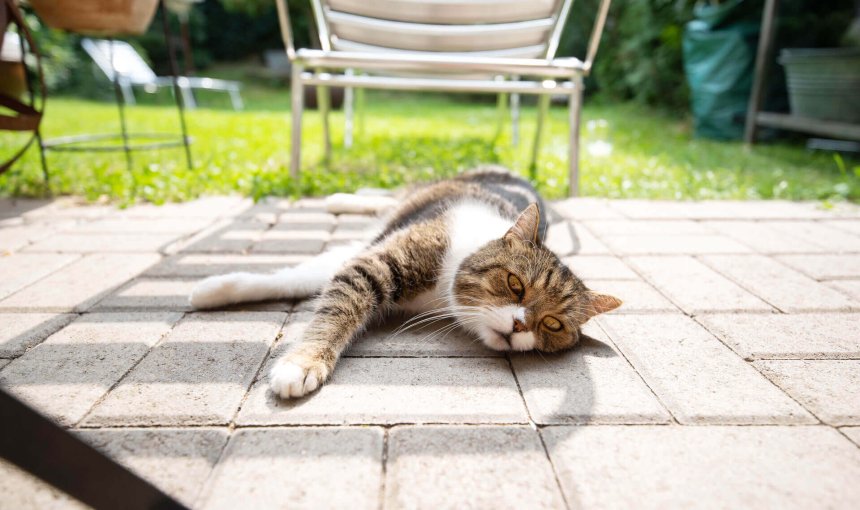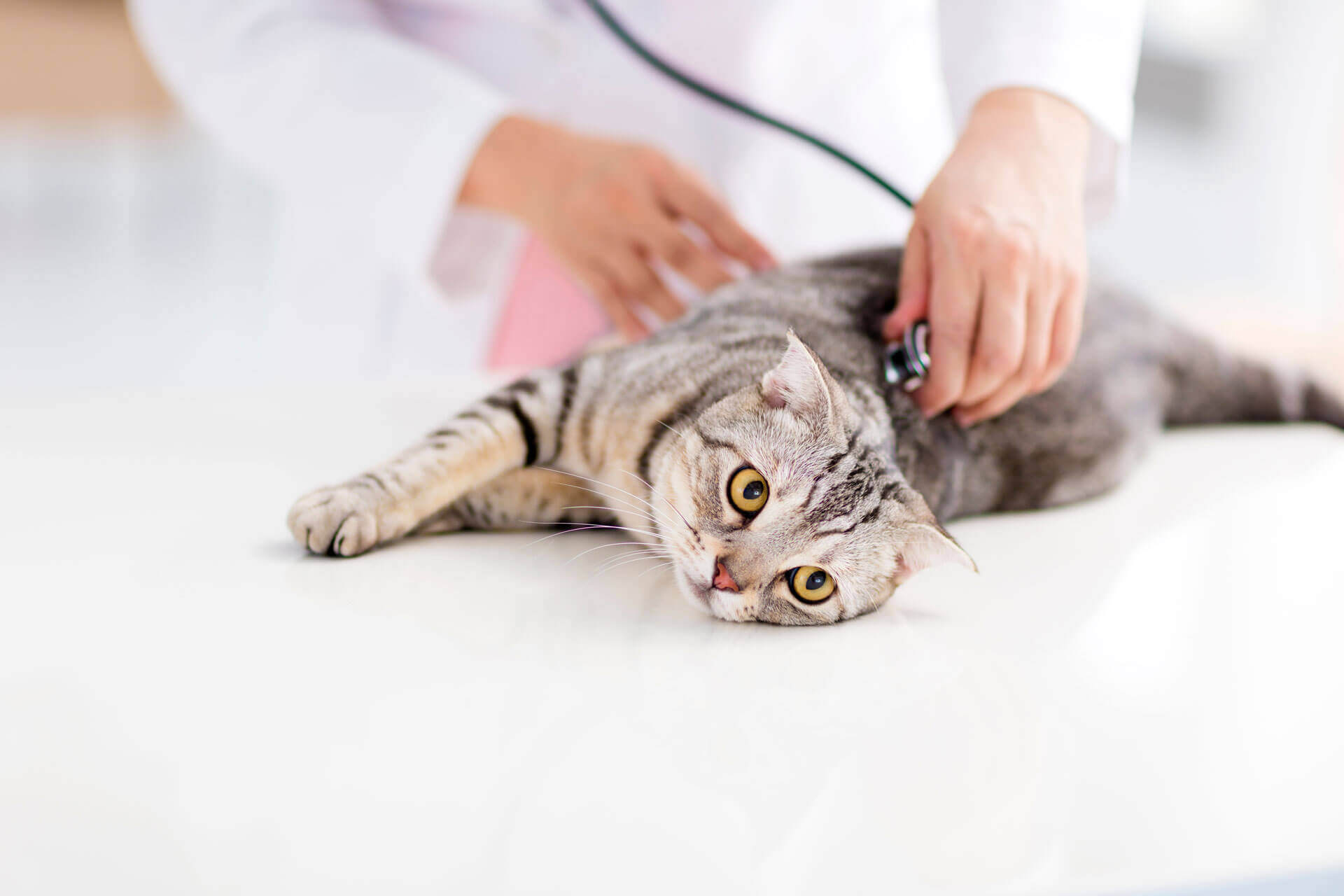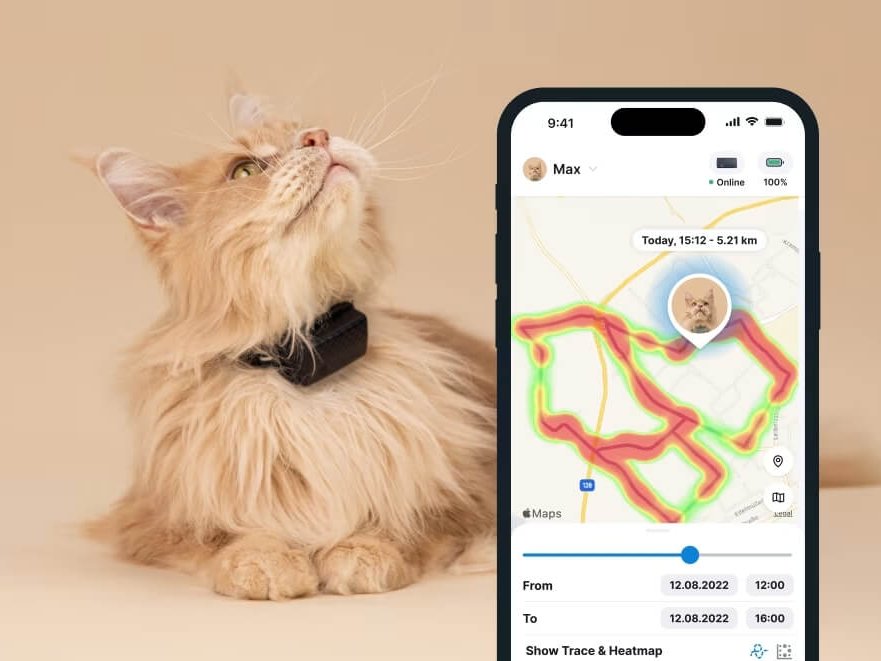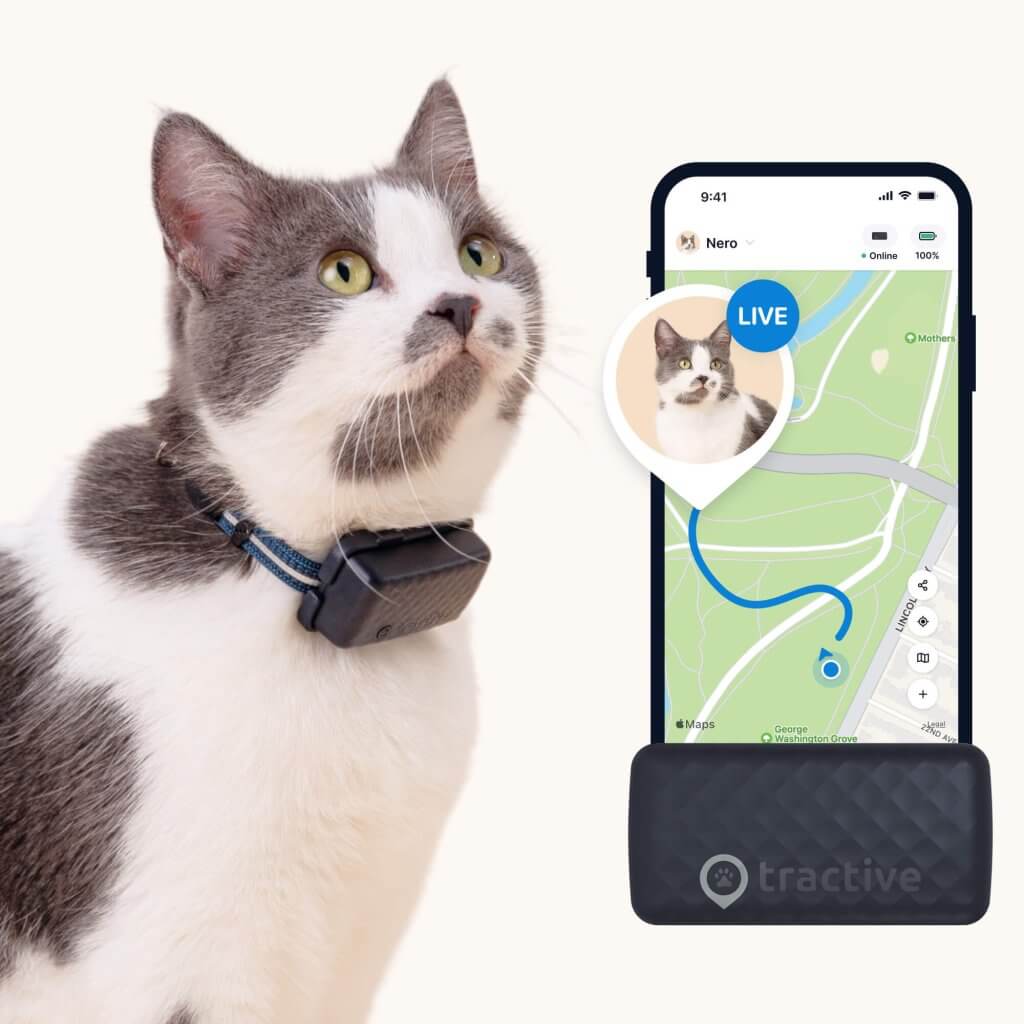Heat Stroke In Cats: Helping Your Buddy Stay Cool
Cats love to warm up in the sun, but how much heat is too much? Learn how to avoid dangerous overheating in your cat with these tips.

Basking in a sunny spot is typical feline behavior, no matter if your buddy likes to hang out indoors or outdors. But when it gets a bit…well, too warm outside, you might just find yourself dealing with the signs of heat stroke in cats. Follow these tips to keep them cool this summer. (Including figuring out where they like to spend most of their time when out and about.)

Find out where your cat spends their time.
Read more- What is heat stroke in cats?
- How do cats sweat & manage their body temperature?
- Reasons that cats become overheated
- Signs of heat exhaustion or heat stroke in cats
- Causes of heat stroke in cats
- How to take a cat’s temperature?
- How to cool down a cat
- How you can prevent heat stroke in cats
- Where a cat GPS tracker can help
What is heat stroke in cats?
Heat stroke occurs when your cat’s body temperature becomes dangerously elevated. This condition most often occurs when they’re in a hot environment and have no way escape or cool off. Heat stroke is life-threatening for any animal (or human). Without quick action and veterinary care, your cat could collapse or even die.
Heat stroke vs heat exhaustion: What’s the difference?
Heat stroke always begins with heat exhaustion. If heat exhaustion is not treated, it could progress to deadly heat stroke. The difference between heat exhaustion and heat stroke lies in your cat’s internal body temperature. A cat’s normal body temperature is 100o F to 102.5o F. If a cat shows early signs of overheating and is not treated, its internal body temperature will rise above 102.5o F.
Above 103o F, your cat experiences heat exhaustion and will attempt to cool itself off. If their body temperature continues to rise above 104o F and:
- …your cat is unable to cool itself,
- …or is not removed from a hot area,
…they might develop heat stroke. This counts as a medical emergency, so get in touch with your vet right away if you suspect your cat is experiencing heat stroke.
💡A cat GPS tracker can help you follow your cat’s movements in real-time – and prevent them from venturing into a sun-soaked spot or getting trapped somewhere hot. Or if they’re spending more time outdoors than usual, you can check just where they’re hanging out and make sure they aren’t out in the sun for too long.

How do cats sweat & manage their body temperature?
If your cat doesn’t want to play, run, or go outside on a hot day, they’ll stay indoors and enjoy the air conditioning. This behavior is important because cats cannot regulate their body temperature in the same way that humans or dogs can. When cats get too hot and can’t move to a cool place like a cement floor, sink, or bathtub, they don’t have many options for cooling down.
- They can lick their fur, which has a slight cooling effect as the saliva evaporates.
- Cats also sweat through their paw pads, but the paw pads are a tiny area so this tactic provides only minimal cooling.
- Panting is another cooling strategy, but if your cat is panting, they are already in distress. Panting is one of the early signs of heat exhaustion.
When a cat cannot cool themselves down with these methods and they cannot escape the hot environment they are in, their body temperature will rise. Once your cat’s temperature rises to heat stroke level, their organ systems, including circulatory, neurologic, and urinary, could begin to shut down.
Reasons that cats become overheated
Certain conditions can make your cat more susceptible to overheating. If your cat is high-risk and susceptible to overheating for any reason, it’s best to keep them indoors.
- Excessive weight
Cats that are obese or overweight may be more likely to overheat, especially in warm weather. - Breed characteristics
Some cat breeds, such as Persians, have shorter noses so their airway is shorter as well. This means that when hot air is breathed in, the air has a shorter distance to travel inside the body and therefore has less opportunity to cool off before reaching the lungs. - Coat characteristics
Long-haired cat breeds, including Persian, Maine coon, ragdoll, and Himalayan, are more prone to overheating due to the thickness and length of their fur. - Existing medical conditions
Cats with breathing difficulties, heart disease, or who are being treated for other medical conditions may be at higher risk for heat exhaustion and heat stroke. - Young or advanced age
Kittens and senior cats may be less able to regulate their internal body temperature than healthy cats. - Excessive anxiety
If a cat is overly anxious, they could be prone to overheating.
Signs of heat exhaustion or heat stroke in cats
As a cat’s body temperature rises and they are unable to cool off, they will first experience the early signs of heat exhaustion. If heat exhaustion is not treated, the body temperature could continue to rise and symptoms will progress, leading to heat stroke.
Symptoms of heat exhaustion
- Panting or drooling
- Sweating from paw pads
- Excessively licking fur to cool down
- Restlessness or anxiety
- Internal body temperature of 103o F to 104o F
If you notice any of these signs, do your best to cool them down immediately. If the early signs of heat exhaustion are not addressed, it can lead to heat stroke.
Symptoms of heat stroke
If your cat shows signs of heat stroke, their internal organs may already be shutting down. Head to your vet right away if you notice:
- Internal body temperature of 104o F to 105o F or higher
- Rapid breathing
- Rapid pulse
- Red tongue or mouth
- Vomiting
- Diarrhea
- Clumsiness or staggering
- Lethargy or weakness
- Drooling with thick saliva due to dehydration
- Tremors
- Seizures
- Collapse
- Coma

Causes of heat stroke in cats
- Trapped in a hot environment
Like a garage, greenhouse, shed, car, outdoors, or clothes dryer. - Lack of access to water
Cats don’t need as much water as dogs in general. But on a hot day, lack of access to cold water can make them overheat. - Heat stroke when staying outside
Make sure that your cat has access to water and a cool, shady spot that is well-ventilated. In extreme heat, bring your cat indoors into the air conditioning. In general, if it’s too hot for you, it’s too hot for your cat. - Leaving cats inside cars and other vehicles
On a sunny day, temperatures inside a vehicle can climb above 140o F within minutes, trapping your cat with no way to escape the heat. - Heat stroke during travel
Make sure to keep the travel crate out of direct sun for prolonged periods. Close the sunroof, place the crate on the floor of the back seat, and make sure the air conditioning vents are open in the back of the car. - Excessive exercise
If your cat enjoys playing or walking with you outside, schedule these sessions for the coolest parts of the day – usually early morning or late in the evening. Avoid intense activity if the outdoor temperature is above 75o F degrees. If you do take kitty for a walk, protect their feet from hot pavement. - Previous heat stroke
If your cat has suffered heat stroke in the past, they may be more prone to heat-related stress.
How to take a cat’s temperature?
The most accurate way to take a cat’s temperature by inserting a pediatric rectal thermometer into the cat’s rectum. A cat’s normal internal body temperature is between 100o F to 102.5o F. Body temperatures above 103o F could signal that something is wrong, so it’s best to have your cat evaluated by a veterinarian. Temperatures above 105o F are life-threatening.
You will need:
- A blanket or towel to wrap your cat in to prevent wriggling.
- Gloves or a long-sleeved shirt to cover your arms and hands to prevent scratches.
- A pediatric rectal thermometer. A digital thermometer will give you faster results. Keep this thermometer separate from yours so it’s only used on the cat. Avoid using an old-style mercury thermometer, which could break if your cat struggles during this procedure.
- Vaseline or other lubricant.
How to take your cat’s temperature:
- Put lubricant on the rectal thermometer.
- Wrap your cat in a towel or blanket and have someone hold the cat.
- Insert the thermometer into the cat’s rectum, about ½ to 1 inch. Leave it in for a few minutes, or until the digital thermometer beeps.
- Remove the thermometer and read the temperature.
- Clean the thermometer thoroughly.
It’s also possible to take a cat’s temperature by inserting a thermometer in the ear, but this is not always accurate. If the thermometer shows that your cat’s temperature is above 102.5o F, take immediate steps to cool them off and contact your vet if their temperature continues to climb.
How to check a cat’s temperature without a thermometer
If you do not have a thermometer available, there are other ways to check for elevated body temperature.
- Check your cat’s nose
Is it moist or dry? Dryness can indicate that your cat is too hot or is dehydrated. - Feel your kitty’s ears
Cats’ ears normally feel warm, but when cats overheat, their ears feel extremely hot. - If your cat is panting, lethargic, or exhibiting any other signs of heat exhaustion or heat stroke, seek immediate medical care and cool them off.
How to cool down a cat
- Remove your cat from the hot location and go somewhere cool such as an air-conditioned building or into deep shade.
- Offer your cat cool water, but do not force them to drink.
- It may help to lay your cat on wet towels. Don’t wrap your cat in the wet towels as this may actually trap heat. If possible, place ice packs between the cat’s legs.
- Bring your cat to the veterinarian as soon as possible. They may offer intravenous fluids to cool your cat internally. Your cat’s body temperature will be closely monitored. If organ damage is suspected, your cat may be hospitalized.
How you can prevent heat stroke in cats
- Keep your cat indoors
Preferably with air conditioning, on very hot days. A rule of thumb when setting indoor temperatures is that if you are comfortable, your cat probably will be, too. Depending on the season, setting your thermostat somewhere between 65-75o F is a good place to start. - Always have fresh cool water available for your cat.
Cats don’t drink copious amounts of water, but if you set out a bowl of fresh cool water every morning, kitty will take quick sips throughout the day. A 10-pound cat should drink about 10 ounces of water per day – a little more than one measuring cup. If your cat has multiple hangouts – such as inside your home, on a screen porch, garage, or barn – be sure to place fresh water in each of these locations every day. - Watch out for spaces your cat might get “stuck” in
Never leave your cat, or any pet, inside a parked car. Likewise, always check the clothes dryer before starting to make sure your cat is not snoozing inside. If your cat is in a crate or pet carrier, keep them out of direct sunlight. Check sunrooms, sheds, garages, or other confined spaces where your cat could be trapped.
Where a cat GPS tracker can help
If your cat is an outdoor cat and fond of spending time outdoors, a cat GPS tracker can be a potential lifesaver. Strapped to your cat’s collar, you can now:
- Track your cat’s location in real-time
With LIVE tracking, your cat’s real-time location gets updated via your Tractive mobile app every few seconds. Plus, unlike the Apple AirTag, Tractive GPS trackers work over an unlimited range – without any need for a network of compatible devices to work. - Figure out where your cat is spending most of their time
From your cat’s Heat Map and Location History. So if your cat’s been hanging outdoors or in any “hot spots”, you can take action right away. - Catch on to any concerning signs of heat stress early
With its built-in motion detector, your trusty Tractive device also monitors your cat’s active minutes – or how often they’ve been on the move. You’ll get alerted if there’s a weird drop in your cat’s activity. (Which could signal any incoming lethargy or sickness.) - Get alerted if your cat ventures into any “no go zones” in your neighborhood
You can set up a “safe zone” around your home or backyard – or “no go zones” elsewhere. Now if your cat leaves the safe zone or enters a no go zone, you’ll get an escape alert on your phone.

All this in one device – built with love for cats and for your peace of mind as a cat parent.

Track your cat wherever they go
Get real-time location information, wherever they go. Find out when they go somewhere they shouldn’t, with Virtual Fences. And discover their favorite spots with Territory.
And if you’ve liked this post, share it with a friend or a loved one – and let’s help build a safer, kinder world for our furry friends together.



